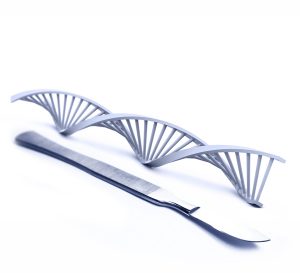 There are new developments in genetics coming to light every day, each with the potential to dramatically change life as we know it. The increasingly controversial gene editing system, dubbed CRISPR (Clustered Regularly Interspaced Short Palindromic Repeats), is at the root of it all. Harnessed for use in genome editing in 20131, CRISPR has given hope to researchers looking to solve various biological problems. It’s with this technology that researchers anticipate eventually having the means to genetically modify humans and rid society of genetic disorders, such as hemophilia. While this is not yet possible, the building blocks are steadily being developed. Most recently, two groundbreaking studies concerning CRISPR have been released to the public.
There are new developments in genetics coming to light every day, each with the potential to dramatically change life as we know it. The increasingly controversial gene editing system, dubbed CRISPR (Clustered Regularly Interspaced Short Palindromic Repeats), is at the root of it all. Harnessed for use in genome editing in 20131, CRISPR has given hope to researchers looking to solve various biological problems. It’s with this technology that researchers anticipate eventually having the means to genetically modify humans and rid society of genetic disorders, such as hemophilia. While this is not yet possible, the building blocks are steadily being developed. Most recently, two groundbreaking studies concerning CRISPR have been released to the public.
In the first study, by Harvard Medical School and Wyss Institute for Biologically Inspired Engineers, researchers used CRISPR to store and recover a short movie in the DNA of Escherichia coli. Wyss Core Faculty member, George Church, Ph. D., led the research team in their journey. The selected clip, created by British photographer Eadweard Muybridge in 1887, shows a black and white video of a galloping racehorse. This clip is widely recognized as the animated footage that lead to the rise of motion pictures.
To begin the process of storing this clip, scientists first divided the footage up into 5 separate frames. For each frame of the video, they split the image up into pixels and then created DNA sequences that corresponded to the each pixel. The sequence held information for what shade of grey the pixel was, as well as the pixel’s location. These DNA sequences, 104 in total, were then translated to the E.coli bacteria at the rate of one frame per day. After this process, researchers were able to retrieve the data from the E.coli, and reconstruct the short film of the racehorse with 90% accuracy 2.
Though this idea of storing movies in genomes is intriguing, it’s the implications of this discovery that are truly extraordinary. The development of this technology could provide scientists the ability to create a molecular recorder, allowing them to use cells to access information they have not previously had access to before. Seth Shipman, a neurologist and the lead investigator in the study, hopes to use CRISPR to have every cell in the brain recording what is going on as an organ functions.
In the second outstanding study, researchers of Oregon Health and Science University used CRISPR to fix a mutation in a human embryo, a mutation responsible for a condition causing sudden heart failure. They did this by first taking one sperm donor with a mutation in the gene called MYBC3 and a  normal (wild-type) egg donor to create an embryo heterozygous for the mutation. Using CRISPR, researchers were able to target MYBC3 and successfully remove the mutated DNA. The mutated gene leaves behind damaged DNA, which is then repaired by the cell, using the wild-type gene as its template. If the entire process worked correctly, both alleles would be wild-type. In over two-thirds of the trials, homozygosity for wild-type was confirmed 3.
normal (wild-type) egg donor to create an embryo heterozygous for the mutation. Using CRISPR, researchers were able to target MYBC3 and successfully remove the mutated DNA. The mutated gene leaves behind damaged DNA, which is then repaired by the cell, using the wild-type gene as its template. If the entire process worked correctly, both alleles would be wild-type. In over two-thirds of the trials, homozygosity for wild-type was confirmed 3.
While the genetically modified embryo was not implanted after the procedure, this study signifies the beginning of a new era in genomics. It is this study that has eyebrows raised. As our understanding of the CRISPR technology advances, many are skeptical of our ability to regulate and control genetic modification. What will keep parents from eventually handpicking their future child’s genetic makeup, if genes can be modified to alter someone’s personality or make them more intelligent?
While these advances in genomics might be intriguing, they may also be frightening for anyone who has read Aldous Huxley’s Brave New World. As we begin to manipulate genetic traits, will society know where to draw the line? While many will agree these advancements would be beneficial in the treatment of genetic disorders, others worry that they will get out of hand in due time. Everything considered, where do you draw the line? This personal reflection will become enormously important in the coming years.
References
- Ledford, Heidi. (2017) Lights, Camera, CRISPR. Biologists Use Gene Editing to Store Movies in DNA. Nature. Retrieved August 15, 2017 from the World Wide Web: https://www.scientificamerican.com/article/lights-cameras-crispr-biologists-use-gene-editing-to-store-movies-in-dna1/
- Sample, Ian. (2017) Harvard scientists pioneer storage of video inside DNA. The Guardian. Retrieved August 15, 2017 from the World Wide Web: https://www.theguardian.com/science/2017/jul/12/scientists-pioneer-a-new-revolution-in-biology-by-embeding-film-on-dna
- Terry, Lynne. (2017) OHSU scientist successfully modifies DNA in human embryos, report says. The Oregonian. Retrieved August 15, 2017 from the World Wide Web: http://www.oregonlive.com/health/index.ssf/2017/07/ohsu_scientist_edits_dna_in_hu.html
Latest posts by Alyssa Bear (see all)
- The Battle for the Wall Outlet - December 12, 2017
- CRISPR: Gene Editing and Movie Madness - August 18, 2017
- “Reverse” Molecular Reactions in DNA through Mind-Body Interventions - August 4, 2017
